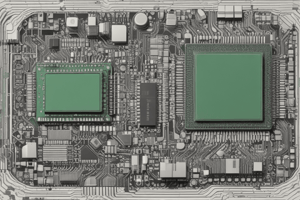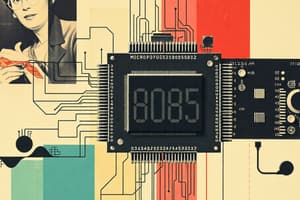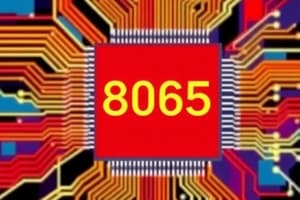Podcast
Questions and Answers
What is the role of the stack pointer register in a microprocessor?
What is the role of the stack pointer register in a microprocessor?
- Provides timing and control signals to the microprocessor
- Decodes the information present in the Instruction register
- Holds temporary data of arithmetic and logical operations
- Works like a stack and is always incremented/decremented by 2 during push and pop operations (correct)
Which register holds the temporary data of arithmetic and logical operations in a microprocessor?
Which register holds the temporary data of arithmetic and logical operations in a microprocessor?
- Stack pointer register
- Temporary register (correct)
- Flag register
- Instruction register
What is the purpose of the flag register in a microprocessor?
What is the purpose of the flag register in a microprocessor?
- Decodes the instructions fetched from memory
- Stores 1-bit flip-flops depending upon the result stored in the accumulator (correct)
- Provides timing and control signals to the microprocessor
- Holds the temporary data of arithmetic and logical operations
Which of the following signals is NOT categorized as a timing and control signal that controls external and internal circuits in a microprocessor?
Which of the following signals is NOT categorized as a timing and control signal that controls external and internal circuits in a microprocessor?
What is the main function of the instruction decoder in a microprocessor?
What is the main function of the instruction decoder in a microprocessor?
When an interrupt occurs during the execution of a main program on a microprocessor, what action does the microprocessor take?
When an interrupt occurs during the execution of a main program on a microprocessor, what action does the microprocessor take?
What is the configuration of the 8085 microprocessor in terms of address bus and data bus?
What is the configuration of the 8085 microprocessor in terms of address bus and data bus?
What is the purpose of the Accumulator in the 8085 microprocessor?
What is the purpose of the Accumulator in the 8085 microprocessor?
Which functional unit of the 8085 microprocessor is responsible for performing arithmetic and logical operations on 8-bit data?
Which functional unit of the 8085 microprocessor is responsible for performing arithmetic and logical operations on 8-bit data?
How many general purpose registers are there in the 8085 microprocessor?
How many general purpose registers are there in the 8085 microprocessor?
What is the function of the program counter in the 8085 microprocessor?
What is the function of the program counter in the 8085 microprocessor?
Which pair of general purpose registers in the 8085 processor can hold 16-bit data?
Which pair of general purpose registers in the 8085 processor can hold 16-bit data?
What are the 5 interrupt signals in 8085 microprocessor?
What are the 5 interrupt signals in 8085 microprocessor?
Which instructions control the serial data communication in 8085 microprocessor?
Which instructions control the serial data communication in 8085 microprocessor?
What is loaded into the address buffer and address-data buffer to communicate with the CPU?
What is loaded into the address buffer and address-data buffer to communicate with the CPU?
How does the data bus differ from the address bus in 8085 architecture?
How does the data bus differ from the address bus in 8085 architecture?
Which buses allow the CPU to exchange desired data with memory and I/O chips?
Which buses allow the CPU to exchange desired data with memory and I/O chips?
Flashcards are hidden until you start studying
Study Notes
Role of the Stack Pointer Register
- The stack pointer register holds the address of the top of the stack in memory, facilitating function calls and local variable storage.
Register for Temporary Data
- The Accumulator register temporarily stores data during arithmetic and logical operations, acting as an essential intermediary in calculations.
Purpose of the Flag Register
- The flag register indicates the status of the CPU and the outcome of operations through condition flags (e.g., zero, carry, sign flags) which inform the execution of future instructions.
Non-Timing Control Signals
- An example of a signal that is not categorized as a timing control signal would be data transfer signals, which focus on communication rather than timing.
Function of the Instruction Decoder
- The instruction decoder interprets the fetched instruction and translates it into control signals that direct other parts of the microprocessor to execute the instruction.
Action on Interrupt Occurrence
- Upon an interrupt, the microprocessor pauses the current execution, saves the context of the program, and initiates the execution of an interrupt service routine.
Configuration of the 8085 Microprocessor
- The 8085 microprocessor has a 16-bit address bus capable of addressing 64 KB of memory and an 8-bit data bus for data transfer.
Purpose of the Accumulator in the 8085 Microprocessor
- The Accumulator is used primarily for arithmetic operations and logical operations, functioning as the primary data register for calculations.
Functional Unit for Arithmetic and Logical Operations
- The Arithmetic Logic Unit (ALU) is responsible for performing all arithmetic and logical operations on 8-bit data within the 8085 microprocessor.
General Purpose Registers in the 8085 Microprocessor
- There are six general-purpose registers in the 8085 microprocessor, labeled as B, C, D, E, H, and L, which are used for temporary data storage during operations.
Function of the Program Counter
- The program counter keeps track of the address of the next instruction to be executed, ensuring sequential execution of programs.
Pair of General Purpose Registers for 16-bit Data
- The H-L register pair and the D-E register pair can hold 16-bit data, allowing for larger data manipulation within the 8085 architecture.
Interrupt Signals in the 8085 Microprocessor
- The five interrupt signals in the 8085 microprocessor include RST7.5, RST6.5, RST5.5, TRAP, and INTR, facilitating external event handling.
Instructions for Serial Data Communication
- The OUT and IN instructions control serial data communication, enabling data exchange between the microprocessor and peripheral devices.
Data Communication Buses
- The address buffer stores addresses while the data bus communicates actual data between the CPU and memory or I/O devices.
Difference Between Data Bus and Address Bus
- The data bus is used for transferring data, whereas the address bus carries addresses to specify where data should be read from or written to in memory.
Buses for CPU Communication
- The address bus, data bus, and control bus are utilized by the CPU to exchange desired data with memory and I/O chips, coordinating system operations.
Studying That Suits You
Use AI to generate personalized quizzes and flashcards to suit your learning preferences.






